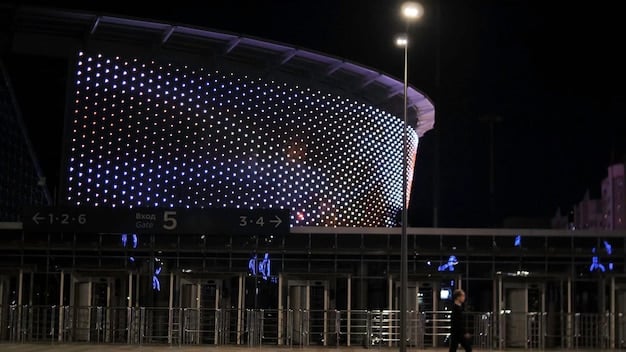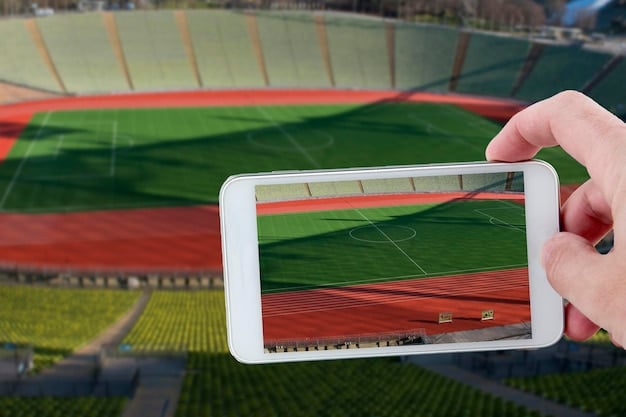The Future of Stadium Design: Enhancing the Fan Experience with Technology

The Future of Stadium Design is revolutionizing the fan experience through advanced technologies such as immersive video, personalized experiences, and data-driven optimizations transforming modern-day sports venues.
The landscape of stadium design is undergoing a dramatic transformation. The integration of technology is not merely an upgrade but a complete reimagining of how fans experience live events.
This evolution is driven by the demand for more engaging, personalized, and immersive experiences. The Future of Stadium Design: How Technology is Enhancing the Fan Experience is not just about bigger screens or better sound systems; it’s about creating a holistic and unforgettable environment for every spectator.
The Evolution of Stadium Technology
Stadiums have always been more than just venues for sports or entertainment; they are communal spaces where memories are made and shared. The integration of technology into stadium design has amplified this, creating more immersive and interactive environments.
Early Innovations in Stadium Design
Initially, stadium innovations focused on structural elements and basic amenities. The introduction of concrete and steel allowed for larger capacities and better sightlines. Basic technology like scoreboards and public address systems improved the spectator experience. However, these were merely functional improvements.
The Digital Transformation
The digital age brought about a fundamental shift. High-definition screens, advanced sound systems, and Wi-Fi connectivity became standard. These advancements laid the groundwork for more sophisticated technologies that now define the modern stadium experience. The focus shifted from simply providing a place to watch a game to creating an interactive and engaging environment.

Here are some examples of Digital Transformations:
- High-Density Wi-Fi: Enables fans to stay connected, share their experiences on social media, and access stadium apps.
- Mobile Ticketing: Streamlines entry processes and reduces wait times.
- Digital Signage: Enhances wayfinding and provides real-time information, improving the overall stadium navigation.
As technology continues to advance, stadiums are becoming smarter, more connected, and more responsive to the needs and desires of their visitors. This digital transformation is reshaping the very essence of the fan experience.
Immersive Video and Augmented Reality
Immersive video and augmented reality (AR) are at the forefront of enhancing the fan experience. These technologies go beyond traditional screens, placing fans at the center of the action.
The Power of Immersive Video
Immersive video technologies, such as 360-degree cameras and virtual reality (VR) headsets, provide fans with a unique and engaging perspective. These tools can transport fans onto the field, into the locker room, or even behind the scenes.
Augmented Reality Overlays
Augmented reality overlays real-time data and graphics onto the live video feed, enriching the viewing experience. Fans can use their smartphones or tablets to point at the field and access player stats, replays, and other interactive content.

Discover some ways Immersive Video and Augmented Reality (AR) are being used in stadiums:
- Interactive Replays: Allows fans to control the viewing angle and speed of replays.
- Real-Time Stats: Provides instant access to player and team statistics.
- Virtual Overlays: Superimposes virtual graphics and animations onto the live action.
The use of immersive video and augmented reality is creating a more dynamic and engaging environment for fans. These technologies are not just enhancing the viewing experience; they are transforming it into an interactive and personalized adventure.
Personalization and Data-Driven Experiences
Personalization is key to enhancing the fan experience. By leveraging data analytics, stadiums can tailor the experience to meet the individual needs and preferences of each visitor.
Leveraging Data Analytics
Data analytics enables stadiums to understand fan behavior, preferences, and demographics. This information can be used to personalize marketing messages, offers, and in-stadium experiences.
Personalized Mobile Apps
Mobile apps can provide personalized content, such as customized news feeds, targeted promotions, and interactive games. These apps can also facilitate mobile ordering, seat upgrades, and other convenient services.
Here are some examples of Personalization Strategies:
- Customized Content: Delivers news, scores, and highlights based on fan preferences.
- Targeted Promotions: Offers discounts and deals on merchandise, food, and beverages.
- Interactive Games: Engages fans with quizzes, trivia, and other interactive content.
Personalization is about making each fan feel valued and understood. By using data analytics and personalized mobile apps, stadiums can create more meaningful and memorable experiences for their visitors. This approach not only enhances fan satisfaction but also drives revenue and loyalty.
Smart Stadiums: Connectivity and Automation
Smart stadiums leverage the Internet of Things (IoT) to create a more connected and automated environment. This includes everything from smart parking and entry systems to automated concessions and restroom management.
Smart Parking and Entry Systems
Smart parking systems guide fans to available parking spaces, reducing congestion and wait times. Automated entry systems, such as facial recognition and mobile ticketing, streamline the entry process and enhance security.
Automated Concessions and Restroom Management
Automated concessions allow fans to order and pay for food and beverages from their seats, reducing lines and improving efficiency. Smart restroom management systems monitor occupancy levels, ensuring cleanliness and minimizing wait times.
Connectivity Through IoT
The Internet of Things enables stadiums to create a more connected and responsive environment. Sensors and devices can track everything from crowd flows to energy consumption, providing valuable insights that can be used to optimize operations and enhance the fan experience.
Smart stadiums are about creating a seamless and efficient environment for fans. By leveraging the Internet of Things and automation, stadiums can reduce friction, improve convenience, and enhance the overall experience.
Sustainability and Eco-Friendly Designs
Sustainability is becoming an increasingly important consideration in stadium design. Eco-friendly designs not only reduce environmental impact but also enhance the fan experience by creating healthier and more comfortable environments.
Renewable Energy Sources
Many modern stadiums are incorporating renewable energy sources such as solar panels, wind turbines, and geothermal systems. These technologies reduce carbon emissions and energy costs, demonstrating a commitment to environmental stewardship.
Water Conservation
Water conservation measures, such as rainwater harvesting and greywater recycling, help stadiums reduce their water footprint. These initiatives not only conserve valuable resources but also reduce operating costs.
Green Building Materials
The use of green building materials, such as recycled steel, sustainable wood, and low-VOC paints, reduces the environmental impact of construction and improves indoor air quality. These materials create healthier and more sustainable environments for fans and employees.
Sustainability is not just about reducing environmental impact; it’s about creating better places for people to live, work, and play. By incorporating eco-friendly designs and practices, stadiums can enhance the fan experience while also contributing to a more sustainable future.
The Future of Stadium Experience: What to Expect
The future of stadium design promises even more immersive, personalized, and sustainable experiences. Here’s a glimpse into what fans can expect in the coming years.
Holographic Projections and Interactive Displays
Holographic projections will bring athletes and performers to life in new and exciting ways. Interactive displays will allow fans to engage with the action on the field and with each other.
Biometric Technologies
Biometric technologies, such as facial recognition and iris scanning, will streamline entry processes and enhance security. These technologies will also enable personalized experiences, such as targeted offers and customized content.
Esports Arenas and Gaming Zones
Stadiums will increasingly incorporate esport arenas and gaming zones, catering to the growing popularity of esports and video games. These spaces will provide fans with new opportunities to engage with their favorite games and players.
| Key Point | Brief Description |
|---|---|
| 💡 Immersive Video and AR | Enhances the fan experience with 360-degree views and real-time stats overlaid on the field. |
| 📱 Personalized Mobile Apps | Tailors content and offers based on fan preferences, improving engagement. |
| 🌐 Smart Stadiums and IoT | Automates processes like parking and concessions for a seamless visit. |
| 🌱 Green Building Materials | Using renewable energy sources and eco-friendly sustainable building materials. |
Frequently Asked Questions (FAQ)
▼
Data analytics enable stadiums to understand fan behavior and preferences, allowing for tailored marketing messages, offers, and in-stadium experiences.
▼
AR overlays real-time data and graphics onto live video feeds, enhancing the viewing experience with player stats, replays, and interactive content that is valuable to the user.
▼
Smart stadiums use IoT to create a connected environment, automating parking, entry systems, concessions, and restroom management for seamless fan experience .
▼
Sustainability reduces environmental impact, lowers operating costs through water conservation and renewable energy, and also makes healthier fan environments .
▼
Holographic projections, biometric technologies, esports arenas, and gaming zones ensure that stadiums are the center of entertainment, incorporating sustainable design practices.
Conclusion
The future of stadium design lies in the innovative integration of technology to create more personalized, immersive, and sustainable experiences. From augmented reality to data-driven personalization and eco-friendly designs, stadiums are evolving into dynamic and engaging spaces that cater to the needs of modern fans. As technology continues to advance, stadiums will become more than just venues for sports and entertainment; they will become hubs of innovation, community, and unforgettable memories.